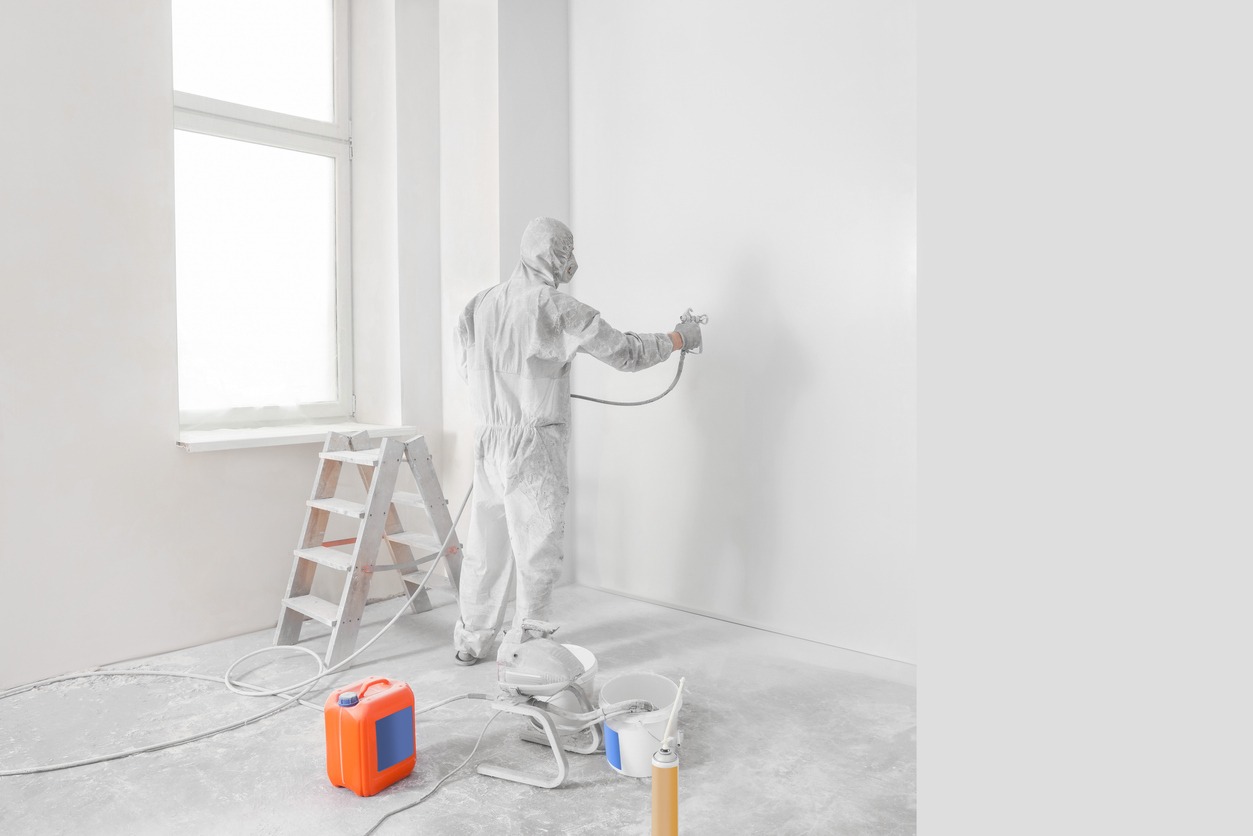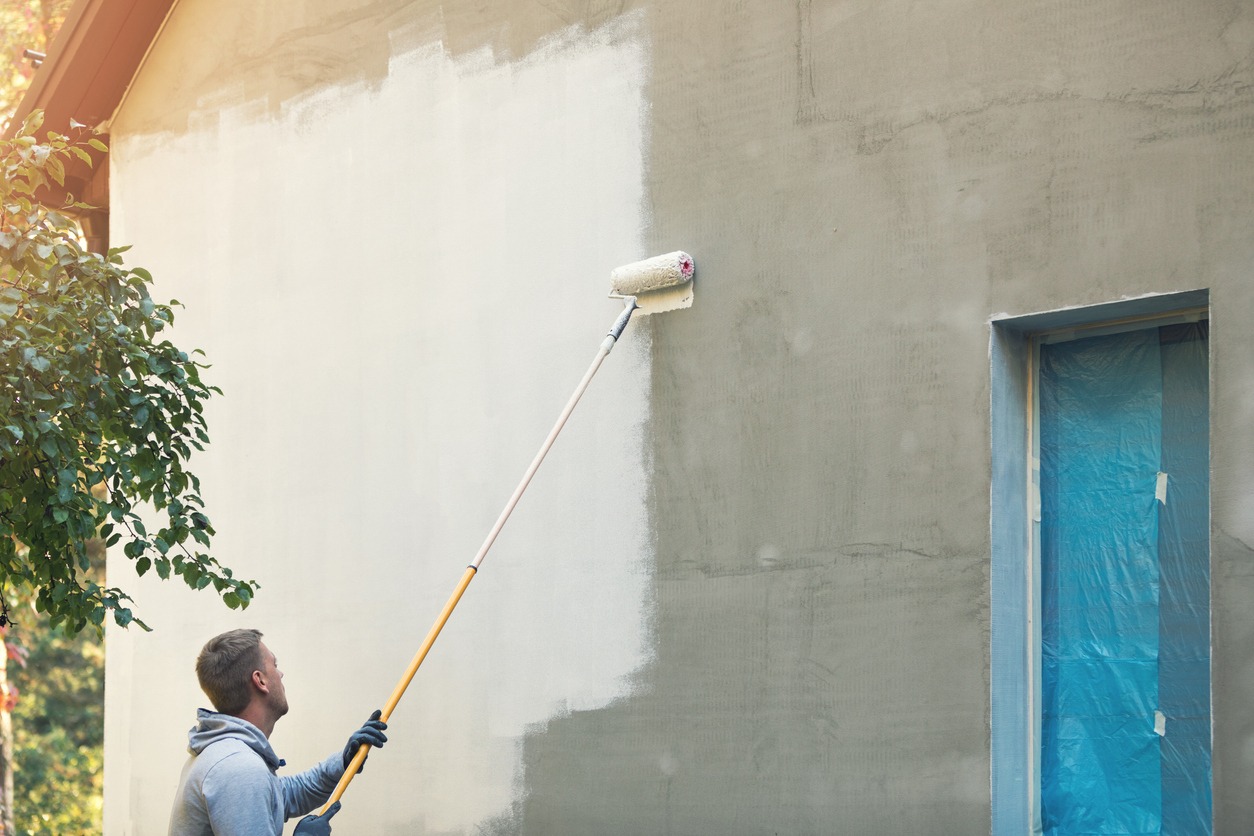When it comes to commercial painting, understanding the differences between interior and exterior projects is key to achieving the best results. For businesses, knowing these distinctions helps with better planning and informed decision-making and ultimately ensures a successful outcome. This blog guides you in navigating the unique challenges and considerations of interior and exterior commercial painting—all shared from a professional painting company’s perspective. Let’s dive in and help you make the most of your next project!
Key differences between interior and exterior commercial painting
Interior and exterior commercial painting differ significantly due to the distinct environments in which they are applied, the materials used, and the techniques employed.
- Interior painting focuses on aesthetics, durability, and functionality in controlled indoor environments.
- Exterior painting, on the other hand, prioritizes resilience against environmental challenges like weather, UV exposure, and temperature fluctuations.
These differences influence every stage of the painting process, from material selection and preparation to application and maintenance.
In the following sections, we’ll delve deeper into the contrasts between interior and exterior commercial painting.
Materials used
Interior paints
- Low-VOC or Zero-VOC Options: Prioritize air quality and safety for enclosed spaces.
- Finishes: Matte, satin, or semi-gloss finishes are chosen for specific areas, balancing durability with aesthetic appeal.
- Durability: Designed to resist scuffs, stains, and frequent cleaning, ensuring longevity in high-traffic indoor areas.
Exterior paints
- Weather-Resistant Formulations: Engineered to withstand environmental factors like rain, UV rays, and extreme temperatures.
- Durability: Focus on protection against fading, peeling, and mildew to maintain appearance and functionality over time.
- Special Additives: Often include UV blockers, mildew inhibitors, and flexible resins to handle outdoor conditions effectively.
Environmental challenges
Interior painting
- Controlled Environment: Interiors are shielded from weather, but challenges include lighting variations that impact color perception and ventilation, potentially influencing drying times and odor management.
- Paint Considerations: Quick-drying, low-odor, or odorless paints are crucial to minimize disruption, especially in occupied spaces. Proper ventilation is essential to ensure safety and optimal drying.
Exterior painting
- Exposure to Elements: Exterior surfaces face weather extremes (rain, sun, snow), moisture, and pollution, which can cause peeling, fading, or cracking over time.
- Paint Considerations: Durable paints with strong adhesion, weatherproofing, UV resistance, and anti-fading properties are essential. Surface preparation and weather timing are critical for long-term results.
Understanding these unique challenges ensures selecting the right materials and techniques for both environments.
Preparation process
Interior preparation
- Protecting Furniture and Flooring: Cover or move furniture and lay down drop cloths to safeguard surfaces from paint splatters.
- Cleaning and Repairing Walls: Washing walls to remove dust and grease, patching holes, and sanding uneven areas for a smooth base.
Exterior preparation
- Pressure Washing: Using pressure washers to remove dirt, mold, and debris for a clean surface.
- Sanding, Caulking, and Repairs: Sanding rough areas, sealing gaps with caulk, and fixing cracks or damage to withstand weather exposure.
Interior preparation focuses on cleanliness and precision for a polished indoor finish, while exterior preparation prioritizes durability and weather resistance.
Application techniques
Interior painting
- Precision: Interior painting emphasizes meticulous attention to detail, especially for trim, edges, and corners. Tools such as angled brushes and painter’s tape are essential for clean lines.
- An Even Coverage: Achieving a smooth, uniform finish is crucial for aesthetic appeal. Multiple thin coats are often applied to avoid streaks and ensure color consistency.
- Controlled Environment: Interiors are painted in stable conditions, minimizing exposure to dust, wind, and fluctuating temperatures.
Exterior painting
- Specialized Tools: Larger surfaces and uneven textures, such as siding or stucco, often require tools like sprayers or rollers with long naps for efficient application.
- Durability: The focus is on applying multiple layers, including primers and topcoats, to protect against weather elements like UV rays, moisture, and temperature changes.
- Challenging Conditions: Exterior painting must account for environmental factors, ensuring proper timing and materials to withstand outdoor exposure.
Both require different techniques and tools tailored to their unique challenges and desired outcomes.
Color selection
Interior painting
- Alignment with Branding: Interior colors should reflect the brand’s personality and values. For instance, calming blues or greens for wellness spaces or vibrant reds and yellows for energetic, creative environments.
- Functionality and Psychological Impact: Choose colors based on room usage. For example, muted tones promote focus in workspaces, while warm colors encourage collaboration or energy in social areas.
- Lighting Influence: Interior lighting significantly affects color perception. Natural light brings out true colors, while artificial lighting may alter hues, requiring testing under different lighting conditions before final selection.
Exterior painting
- Brand Identity and Surroundings: Exterior colors should complement the building’s architecture and surrounding environment while reinforcing the brand. Bold or unique colors may help stand out but must align with the brand’s tone.
- Local Regulations: Compliance with local zoning laws or HOA guidelines may restrict specific color choices.
- Fade-Resistant, High-Visibility Colors: Exterior paints should withstand weather conditions and maintain vibrancy over time, enhancing curb appeal and creating a lasting impression.
Balancing these considerations ensures cohesive and effective color choices for interior and exterior applications.
Maintenance and longevity
Interior painting
- Maintenance: Regular cleaning (e.g., wiping walls) helps maintain a fresh look. You may need touch-ups for high-traffic areas or where damage occurs.
- Longevity: Typically lasts longer due to the controlled indoor environment, with repainting needed every 7-10 years or as desired for aesthetic updates.
Exterior painting
- Maintenance: Requires more attention due to exposure to elements like sun, rain, and temperature fluctuations. Regular inspections and cleaning can help extend the paint’s lifespan.
- Longevity: Exteriors have a shorter lifespan compared to interiors, and repainting is needed every 5-10 years, depending on climate, material, and paint quality. Durable finishes, such as weather-resistant or UV-protective paints, are crucial to minimize maintenance and extend durability.
The key difference lies in exposure to environmental factors, which significantly impact the frequency and type of maintenance required.
Cost differences
Exterior painting
Exterior painting projects are often more expensive than interior ones due to the complexity and additional requirements involved:
- Complexity: Exterior projects often require scaffolding, ladders, and safety equipment to reach high or hard-to-access areas, which increases labor costs.
- Durable Materials: Exterior paints must withstand weather conditions like rain, UV rays, and temperature fluctuations, necessitating more expensive, high-quality materials.
- Preparation: Cleaning, repairing, and priming surfaces (e.g., siding or brick) is more time-intensive, especially if there’s damage or weathering.
Interior painting
Interior painting is generally less costly because:
- Ease of Access: Surfaces are easier to reach, and projects don’t require specialized equipment like scaffolding.
- Materials: Interior paints are typically less expensive, as they don’t need to be weather-resistant.
- Controlled Environment: There’s less risk of weather interruptions, leading to smoother project timelines.
Factors affecting costs for both
- Surface Area: Larger areas require more paint and labor, increasing costs.
- Condition of Surfaces: Damaged or uneven surfaces may need repairs or extra preparation, such as sanding or filling cracks.
- Paint Type: High-quality, specialty or eco-friendly paints can significantly raise costs.
- Labor Costs: Skilled painters charge more, and the complexity of the design or surface can impact labor time.
While interior painting tends to be more budget-friendly, the specific project scope and unique challenges will ultimately determine costs.
Why work with professionals for both?
Interior painting
Professionals bring expertise in crafting visually appealing and functional spaces, considering factors like color psychology, lighting, and layout. They ensure precise application, clean lines, and smooth finishes while minimizing disruption to daily business operations with efficient project management and flexible scheduling.
Exterior painting
Exterior painting requires specialized knowledge of weatherproofing, safety protocols, and surface preparation for a durable and lasting finish. Professionals understand the impact of environmental conditions and use high-quality materials to protect your property from the elements.
Why choose Custom Painting, Inc.?
Custom Painting, Inc. excels in interior and exterior painting projects by combining technical expertise, attention to detail, and exceptional customer service. With a proven track record of transforming spaces and enhancing curb appeal, they ensure your project is completed on time, within budget, and to the highest quality standards.
Parting words
Interior painting focuses on aesthetics, durability, and creating the desired ambiance, while exterior painting prioritizes protection against weather, durability, and curb appeal. Choosing the right materials, techniques, and professionals ensures lasting, high-quality results for interior and exterior projects.
Whether you need interior or exterior commercial painting, Custom Painting, Inc. has the expertise to deliver top-quality results. Contact us today for a free consultation, or call us at 925-294-8062 to set up an appointment to discuss your painting needs!



